Filters: Collection: "ir_uspace"
| Creator | Title | Description | Subject | Date | ||
|---|---|---|---|---|---|---|
| 76 |
 |
Brown, Don R. | The design and implementation of partnet | PartNet is a federated database for providing interactive online access to mechanical parts catalogs. The data contained in the vendor's product database is exported to the federated database using a networkbased distributed database protocol. A Single coherent view of these vendor databases is pro... | 1995 | |
| 77 |
 |
Stoller, Leigh B. | Message passing support in the Avalanche widget | Minimizing communication latency in message passing multiprocessing systems is critical. An emerging problem in these systems is the latency contribution costs caused by the need to percolate the message through the memory hierarchy (at both sending and receiving nodes) and the additional cost of ma... | Avalanche widget; Message passing; Cache coherence; Message copying; Cache miss rates; Computer memory | 1996 |
| 78 |
 |
Orr, Douglas B.; Mecklenburg, Robert | OMOS ? An object server for program execution | The benefits of object-oriented programming are well known but popular operating systems provide very few object oriented features to users and few are im plemented using object oriented techniques themselves In this paper we discuss a mechanism for apply ing object oriented programming co... | OMOS; Object server | 1992 |
| 79 |
 |
Carter, John B.; Davis, Al; Kuramkote, Ravindra; Stoller, Leigh B. | Avalanche: A communication and memory architecture for scalable parallel computing | As the gap between processor and memory speeds widens?? system designers will inevitably incorpo rate increasingly deep memory hierarchies to maintain the balance between processor and memory system performance At the same time?? most communication subsystems are permitted access only to main m... | Avalanche; Communication architecture; Memory architecture | 1995 |
| 80 |
 |
Balasubramonian, Rajeev | Leveraging 3D technology for improved reliability | Aggressive technology scaling over the years has helped improve processor performance but has caused a reduction in processor reliability. Shrinking transistor sizes and lower supply voltages have increased the vulnerability of computer systems towards transient faults. An increase in within-die an... | Reliability; Redundant multi-threading, 3D die-stacking; Parameter variation; Soft errors; Dynamic timing errors; Power-efficient microarchitecture; On-chip temperature | 2007-12 |
| 81 |
 |
Balasubramonian, Rajeev | Power-efficient approaches to reliability | Radiation-induced soft errors (transient faults) in computer systems have increased significantly over the last few years and are expected to increase even more as we move towards smaller transistor sizes and lower supply voltages. Fault detection and recovery can be achieved through redundancy. St... | Radiation-induced; Soft errors; Transient faults; Redundant thread; Trailing thread; Power consumption | 2005 |
| 82 |
 |
Clayton, Paul D. | Emerging Standards for Medical Logic | Biomedical Informatics | 1990 | |
| 83 |
 |
Warner, Homer R. | HELP - A Total Hospital Information System | Biomedical Informatics | 1980 | |
| 84 |
 |
Mitchell, Joyce A. | Preliminary evaluation of learning via the AI/LEARN/Rheumatology interactive videodisc system | AI/LEARN/Rheumatology is a level three videodisc system to teach clinical observational skills in three important diseases: rheumatoid arthritis, osteoarthritis, and ankylosing spondylitis. The AI/LEARN software was developed on an independent authoring system called GALE designed for MS-DOS based c... | 1992-01-01 | |
| 85 |
 |
Gardner, Reed M. | Real Time Data Acquisition: Experience With the Medical Information Bus (MIB) | Biomedical Informatics | 1991 | |
| 86 |
 |
Gardner, Reed M. | Standardizing Communications and Networks in the ICU | Biomedical Informatics | 1985 | |
| 87 |
 |
Brunvand, Erik L. | Translating concurrent programs into delay-insensitive circuits | Programs written in a subset of occam are automatically translated into delay-insensitive circuits using syntax-directed techniques. The resulting circuits are improved using semantics-preserving circuit-to-circuit transformations. Since each step of the translation process can be proven correct, th... | 1989 | |
| 88 |
 |
Gardner, Reed M. | Technology Development Standardization and Evaluation in Pulmonary Medicine | Biomedical Informatics | 1981 | |
| 89 |
 |
Brunvand, Erik L. | A case for increased operating system support in chip multi-processors | We identify the operating system as one area where a novel architecture could significantly improve on current chip multi-processor designs, allowing increased performance and improved power efficiency. We first show that the operating system contributes a non-trivial overhead to even the most com... | 2005 | |
| 90 |
 |
Balasubramonian, Rajeev | A case for increased operating system support in chip multi-processors | We identify the operating system as one area where a novel architecture could significantly improve on current chip multi-processor designs, allowing increased performance and improved power efficiency. We first show that the operating system contributes a non-trivial overhead to even the most com... | 2005 | |
| 91 |
 |
Gardner, Reed M. | Collaboration in Clinical Computing at LDS Hospital | Biomedical Informatics | 1994 | |
| 92 |
 |
Gardner, Reed M. | Computer Support in Critical Care Medicine | Biomedical Informatics | 1980 | |
| 93 |
 |
Warner, Homer R. | HELP - A Computer System for Medical Decision Making | Biomedical Informatics | 1975 | |
| 94 |
 |
Haug, Peter J. | Integrating Radiology and Hospital Information Systems: The Advantage of Shared Data | Biomedical Informatics | 1992 | |
| 95 |
 |
Gardner, Reed M. | Evaluation of User Acceptance of a Clinical Expert System | Biomedical Informatics | 1994 | |
| 96 |
 |
Gardner, Reed M. | Eight-Channel Data Set for Clincal EEG Transmission Over Dial-Up Telephone Network | Biomedical Informatics | 1974 | |
| 97 |
 |
Bradshaw, Karen E. | Improving Efficiency and Quality in a Computerized ICU | Biomedical Informatics | 1988 | |
| 98 |
 |
Gardner, Reed M. | Integration of a Stand-Alone Expert System with a Hospital Information System | Biomedical Informatics | 1992 | |
| 99 |
 |
Stoller, Leigh B. | Low latency workstation cluster communications using sender-based protocols | The use of workstations on a local area network to form scalable multicomputers has become quite common. A serious performance bottleneck in such "carpet clusters" is the communication protocol that is used to send data between nodes. We report on the design and implementation of a class of communic... | Workstations; Scalable multicomputers; Sender-based; Communication protocols | 1996 |
| 100 |
 |
Zhang, Lixin | Reference manual of impulse system calls | This document describes the Im pulse system calls. The Impulse system calls allow user applications to use remapping functionality provided by the Impulse Adaptive Memory System to remap their data structures. Impulse supports several remapping algorithms. User applications choose the desired remapp... | Impulse system calls; Remapping functionality; Impulse Adaptive Memory System; Remapping algorithms | 1999 |
